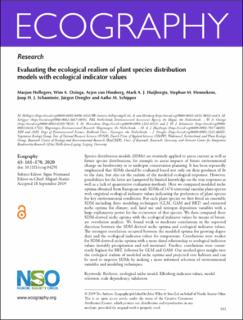Please use this identifier to cite or link to this item:
https://doi.org/10.21256/zhaw-18467Full metadata record
| DC Field | Value | Language |
|---|---|---|
| dc.contributor.author | Hellegers, M. | - |
| dc.contributor.author | Ozinga, W.A. | - |
| dc.contributor.author | van Hinsberg, A. | - |
| dc.contributor.author | Huijbregts, M.A.J. | - |
| dc.contributor.author | Hennekens, S.M. | - |
| dc.contributor.author | Schaminée, J.H.J. | - |
| dc.contributor.author | Dengler, Jürgen | - |
| dc.contributor.author | Schipper, A.M. | - |
| dc.date.accessioned | 2019-10-18T08:23:51Z | - |
| dc.date.available | 2019-10-18T08:23:51Z | - |
| dc.date.issued | 2020 | - |
| dc.identifier.issn | 1600-0587 | de_CH |
| dc.identifier.uri | https://digitalcollection.zhaw.ch/handle/11475/18467 | - |
| dc.description.abstract | Species distribution models (SDMs) are routinely applied to assess current as well as future species distributions, for example to assess impacts of future environmental change on biodiversity or to underpin conservation planning. It has been repeatedly emphasized that SDMs should be evaluated based not only on their goodness of fit to the data, but also on the realism of the modelled ecological responses. However, possibilities for the latter are hampered by limited knowledge on the true responses as well as a lack of quantitative evaluation methods. Here we compared modelled niche optima obtained from European-scale SDMs of 1,476 terrestrial vascular plant species with empirical ecological indicator values indicating the preferences of plant species for key environmental conditions. For each plant species we first fitted an ensemble SDM including three modeling techniques (GLM, GAM and BRT) and extracted niche optima for climate, soil, land use and nitrogen deposition variables with a large explanatory power for the occurrence of that species. We then compared these SDM-derived niche optima with the ecological indicator values by means of bivariate correlation analysis. We found weak to moderate correlations in the expected direction between the SDM-derived niche optima and ecological indicator values. The strongest correlation occurred between the modelled optima for growing degree days and the ecological indicator values for temperature. Correlations were weaker for SDM-derived niche optima with a more distal relationship to ecological indicator values (notably precipitation and soil moisture). Further, correlations were consistently highest for BRT, followed by GLM and GAM. Our method gives insight into the ecological realism of modelled niche optima and projected core habitats and can be used to improve SDMs by making a more informed selection of environmental variables and modeling techniques. | de_CH |
| dc.language.iso | en | de_CH |
| dc.publisher | Wiley | de_CH |
| dc.relation.ispartof | Ecography | de_CH |
| dc.rights | http://creativecommons.org/licenses/by/3.0/ | de_CH |
| dc.subject | Ecological indicator values | de_CH |
| dc.subject | Species distribution model | de_CH |
| dc.subject.ddc | 333.7: Landflächen, Naturerholungsgebiete | de_CH |
| dc.title | Evaluating the ecological realism of plant species distribution models with ecological indicator values | de_CH |
| dc.type | Beitrag in wissenschaftlicher Zeitschrift | de_CH |
| dcterms.type | Text | de_CH |
| zhaw.departement | Life Sciences und Facility Management | de_CH |
| zhaw.organisationalunit | Institut für Umwelt und Natürliche Ressourcen (IUNR) | de_CH |
| dc.identifier.doi | 10.1111/ecog.04291 | de_CH |
| dc.identifier.doi | 10.21256/zhaw-18467 | - |
| zhaw.funding.eu | No | de_CH |
| zhaw.issue | 1 | de_CH |
| zhaw.originated.zhaw | Yes | de_CH |
| zhaw.pages.end | 170 | de_CH |
| zhaw.pages.start | 161 | de_CH |
| zhaw.publication.status | publishedVersion | de_CH |
| zhaw.volume | 43 | de_CH |
| zhaw.publication.review | Peer review (Publikation) | de_CH |
| zhaw.webfeed | Vegetationsökologie | de_CH |
| zhaw.author.additional | No | de_CH |
| Appears in collections: | Publikationen Life Sciences und Facility Management | |
Files in This Item:
| File | Description | Size | Format | |
|---|---|---|---|---|
| Hellegers_et_al-2020-Ecography.pdf | 1.74 MB | Adobe PDF |  View/Open |
Show simple item record
Hellegers, M., Ozinga, W. A., van Hinsberg, A., Huijbregts, M. A. J., Hennekens, S. M., Schaminée, J. H. J., Dengler, J., & Schipper, A. M. (2020). Evaluating the ecological realism of plant species distribution models with ecological indicator values. Ecography, 43(1), 161–170. https://doi.org/10.1111/ecog.04291
Hellegers, M. et al. (2020) ‘Evaluating the ecological realism of plant species distribution models with ecological indicator values’, Ecography, 43(1), pp. 161–170. Available at: https://doi.org/10.1111/ecog.04291.
M. Hellegers et al., “Evaluating the ecological realism of plant species distribution models with ecological indicator values,” Ecography, vol. 43, no. 1, pp. 161–170, 2020, doi: 10.1111/ecog.04291.
HELLEGERS, M., W.A. OZINGA, A. VAN HINSBERG, M.A.J. HUIJBREGTS, S.M. HENNEKENS, J.H.J. SCHAMINÉE, Jürgen DENGLER und A.M. SCHIPPER, 2020. Evaluating the ecological realism of plant species distribution models with ecological indicator values. Ecography. 2020. Bd. 43, Nr. 1, S. 161–170. DOI 10.1111/ecog.04291
Hellegers, M., W.A. Ozinga, A. van Hinsberg, M.A.J. Huijbregts, S.M. Hennekens, J.H.J. Schaminée, Jürgen Dengler, and A.M. Schipper. 2020. “Evaluating the Ecological Realism of Plant Species Distribution Models with Ecological Indicator Values.” Ecography 43 (1): 161–70. https://doi.org/10.1111/ecog.04291.
Hellegers, M., et al. “Evaluating the Ecological Realism of Plant Species Distribution Models with Ecological Indicator Values.” Ecography, vol. 43, no. 1, 2020, pp. 161–70, https://doi.org/10.1111/ecog.04291.
Items in DSpace are protected by copyright, with all rights reserved, unless otherwise indicated.